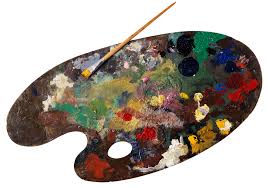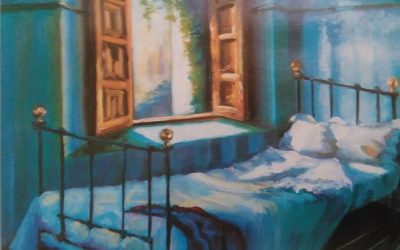Alla Prima is an Italian expression which can be translated as first hand. Painting Alla Prima is a technique in which you finish your painting quickly in one session which is different from the traditional painting which is adding layers of paint in a longer period of time.
This technique is used usually when painters are working outdoors directly on a model and the speed is vital in order to capture the flickering nature of light and movement in the landscape. In painting Alla Prima you do not paint in layers although painters sometimes do make sketches with charcoal sticks or diluted paint.
Every smear made with paint is pretty much what you will get on the finished painting. The basic idea is to capture the essence of the theme with decisive brush strokes and minimal colour mixing.
Painting Alla Prima requires a confident approach. It is, of course, possible to scrape off the parts of the painting that you made a mistake on but that might destroy the entire composition making it lose its spontaneity and freshness. So it is very important to start working with a very clear idea of what you want to create.
Be decisive and don’t be tempted to add any unnecessary details to your work.


Spring flowers
To paint this painting you will need the following:
- Primmed linen canvas
- Round Hog bristle brush number 2
- Filbert Hog bristle brush number 2
- Filbert Hog bristle brush number 8
- Flat Hog bristle brush number 10
- Turpentine or odourless mineral spirits
- Linen oil
- Clean
rag
and the following colours:
- Naples Yellow
- Chrome Yellow
- Permanent Pink
- Cadmium Red
- Burnt Sienna
- Cadmium Green
- Ochre Yellow
- Alizarin Red
- Olive Green
- French Ultramarine
- Cobalt Blue
- Cobalt Purple
- Titanium White
Preparation for painting
Prepare the canvas by toning it one day before you start painting so the paint has time to dry of. Mix Ochre Yellow, French Ultramarine and a little bit of Cadmium Green and dilute it with a lot of turpentine or odourless mineral spirits to get a very thin film of pale grey-green.
Use the rag soaked in turpentine or odourless mineral spirits to rub the colour on to the canvas. With the same colour make a rough sketch of your composition using the Filbert brush number 2. To sketch a vase use French Ultramarine, Titanium White and Cobalt Purple use to sketch the tulips and Cadmium Green use to sketch the flower stems. Hold the brush away from the bristles and paint with relaxed fluid strokes.
Determine the brightest tones in your composition using the technique of erasing. Wrap the rag soaked in turpentine or odourless mineral spirits around your finger and use it to remove the paint from the canvas on desired areas, for example where the daisies are and where are the white areas on the tablecloth.


Building the composition
Now start working on building the composition in whole painting the similar areas simultaneously. Mix Burnt Sienna, Ochre Yellow and a bit of Cadmium Red to get warm brown colour and using the flat bristle brush number 10 cover the background of the painting with wide relaxed moves.
With a mixture of French Ultramarine, Alizarin Red and White paint the shades and the ridges on the tablecloth. Using Ultramarine paint the vase following her curved shape with the strokes of your brush. Paint the leaves of the tulips with Cadmium Green, for darker leaves ad to it a bit of Ultramarine to create a glimpse of grey.
In order to determine the shapes of flowers use filbert brush number 8. For daisies use pure white and white with a bit of Naples Yellow. Paint lighter and darker shades of the tulips using different mixtures of Cobalt Purple, Cobalt Blue, Permanent Pink and White. Ad the paint quickly, don’t linger on the details, instead of that pay attention to the movement of the petals and try to capture them.

Finishing touches
By now your painting has already gained shape and form and it is time to use thicker paint mixed with turpentine or odourless mineral spirits and linen oil. Build the reflections on the vase using Ultramarine mixed with a bit of Cobalt Purple for the darkest tones and Cobalt Blue mixed with white for palest tones.
Work on the ridges of the tablecloth emphasizing the shades with the mixture of Burnt Sienna and Cobalt Purple with the addition of white for higher areas. Make your brash move all the time and work on all areas of the canvas simultaneously.
Continue working on the vase using the same colours you used already. Ad traces of Cobalt Purple to depict the colour of the tulips and smears of pure white for the lightest area. Ad tone and form to the leaves with the mixture of Olive Green and Cadmium Green again adding white for the lightest areas.
With round brush number 2 using Cobalt Purple paint the shape of tulips. To paint the background behind the flowers use flat brush number 10 and the mixture of Burnt Sienna, Ochre Yellow, Chrome Yellow and Cadmium Red.
Paint the embroidered flowers on the table cloth using French Ultramarine, Cobalt Blue and White for the petals, Chrome Yellow for the centre of the flower and Cobalt Green mixed with Cobalt Blue for stems and leaves.
Ad more white mixed with a little bit of Cobalt Blue on the ridges around the base of the vase. Using round brush number 2 paint pointy petals of the daisies using pure white.
Continue working on tulips using the mixture of Cobalt Blue, Permanent Pink and pure white and for the stamens use Cobalt Purple. Let your brush strokes follow the curved shapes of the petals and let the colours mix wet on wet on the canvas.
Mix Cobalt Purple and White and paint little dots for tiny carnations.
Step away from the painting and check if it needs any more finishing touches. Don’t be tempted to add any unnecessary details because if you do your painting Alla Prima will lose its freshness.
If you have any questions regarding the subject please feel free to leave them below and I will be more than happy to answer.





0 Comments